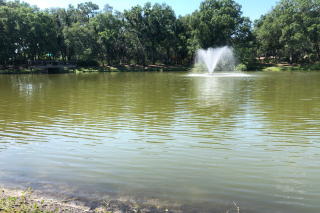Zombie Ponds to Living Community Ponds
Community Resources
Overview
USF's Stormwater Research
Researchers from the Department of Civil and Environmental Engineering at USF are currently conducting research on stormwater systems in the University Area with a focus on improving community knowledge and stormwater quality. This research involves the installation and monitoring of a new stormwater filtration system designed to reduce the inflow of stormwater contaminants to Aarans Pond. By constructing features that place natural plants and the absorbent material biochar at inflow locations where stormwater enters a pond, these "Biopods" should help to improve stormwater quality by helping to filter out contaminants like excess nitrogen before they enter the pond. While seeking to raise community awareness and knowledge of stormwater issues. USF is also seeking the rich knowledge of local community members to better learn about community concerns, desires, and suggestions, related to stormwater pond redesign. This is an important step towards achieving healthier stormwater, a healthier community, and a healthier environment.
Stormwater information
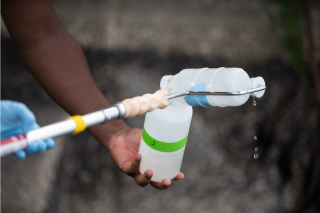
On the pages below you can find some helpful information designed to explain what exactly stormwater is, why it's important, and what the risks of contaminated stormwater or unhealthy stormwater systems can be. These pages come paired with additional helpful links or resources if you want to learn even more. Additionally, there is some information on the history and function of Aarans pond as part of the University area's stormwater system alongside some student produced films that highlight resident experiences and the challenges of stormwater redevelopment.
What is stormwater?
What is Stormwater and why is it important?

The term "Stormwater", refers to the water that is produced from rainstorms and other weather events once it reaches the ground. As rainfall reaches the surface of the earth, it becomes stormwater runoff that naturally flows to lower areas to be reabsorbed into the earth or into manmade stormwater systems built to capture this overflow and prevent issues like flooding. Stormwater collection features can include roadside canals, streetdrains, roadside depressions, and sewers. These features help to guide stormwater into reservoirs such as stormwater ponds and alleviate the chance for excess water to build up and flood homes or roadways. Although stormwater also does come to eventually settle in natural bodies of water such as lakes, ponds, and rivers. Beyond the danger of flooding, stormwater can still pose other environmental problems due to stormwater pollution. Stormwater can easily collect pollutants such as bacteria, phosphates from left over fertilizer, industrial waste like oils or soaps, and other forms of waste like trash as it flows. Eventually, depositing these same substances into the surrounding environment.
Permeablility

Hard Impermeable features like roads and sidewalks trap stormwater and can cause flooding.

Green features like natural ground are permeable surfaces that can easily absorb excess water.
Places that are heavily developed with an abundance of hard surfaces such as roads, sidewalks, parking lots, and buildings can find themselves more vulnerable to flooding due to an absence of permeable surfaces. A permeable surface is a surface where water can easily be absorbed into the earth such as with natural ground and other green features of the landscape. Impermeable surfaces like sidewalks are hard features that cannot be penetrated and instead cause water to become runoff that must flow off the surface into the ground or a stormwater feature instead. With more impermable surfaces there comes a greater reliance on stormwater systems to handle excess water.
Stormwater Ponds: Where water and more goes

A stormwater pond is a constructed pond feature designed to capture and hold excess stormwater. These ponds can appear as large bodies of seemingly natural water or appear as a low lying area that normally sits dry outside of the rainy season. These spaces may also be homes, feeding grounds, and habitat for different kinds of local wildlife. Stormwater ponds are critical parts of the landscape and especially important for areas like the University Area with many impermeable surfaces because they serve to prevent flooding by recieving water from inflows linked to built pieces of the local stormwater drainage system. Stormwater ponds however, can also become heavily polluted due to regularly recieving the same contaminants picked up by the stormwater that comes to enter the pond. Stormwater pond contamination poses not just a risk to widlife and the surrounding environment, but also to anyone who may come in contact with the polluted pondwater.
Learn more about stormwater health
- Tampa Bay Water Atlas: Stormwater
- Tampa Bay Waterkeeper: Stormwater Pollution
- EPA: Sources and Solutions, Stormwater
- (SWFWMD) Stormwater pond Q&A
Stormwater Contaminants
What are stormwater Contaminants?
Stormwater contaminants are all of the things that can be abosorbed or collected through stormwater runoff and come to negatively impact water quality and the health of the stormwater system. Some common types of stormwater contaminants include, Chemicals and other hazardous substances, Pet waste/sewage, Fertilizers, and other forms of hard waste such as trash.
Chemicals and other hazardous substances
One major form of stormwater contaminantion comes from the natural or unnatural waste products of human activity. These contaminants include toxic metals such as lead, chemicals, grease, and even industrial byproducts like motor oil/car byproducts, microplastics, and powder residue from industrial sites. Even common household items like cleaners, soaps, insect poisons, and cooking oils can become a stormwater contaminant without proper disposal. In a heavily developed space like the University area, these contaminants may be present in greater ammounts due to a higher compaction of human activity, buisnesses, and industrial locations. These kinds of contaminants harm the water quality of a stormwater pond and can be ingested by animals or absorbed by people through contact with contaminated water.

Chemicals and other residue like automobile oils can contaminate bodies of water.

Common household items like cleaners can become hazardous to stormwater if dumped improperly.
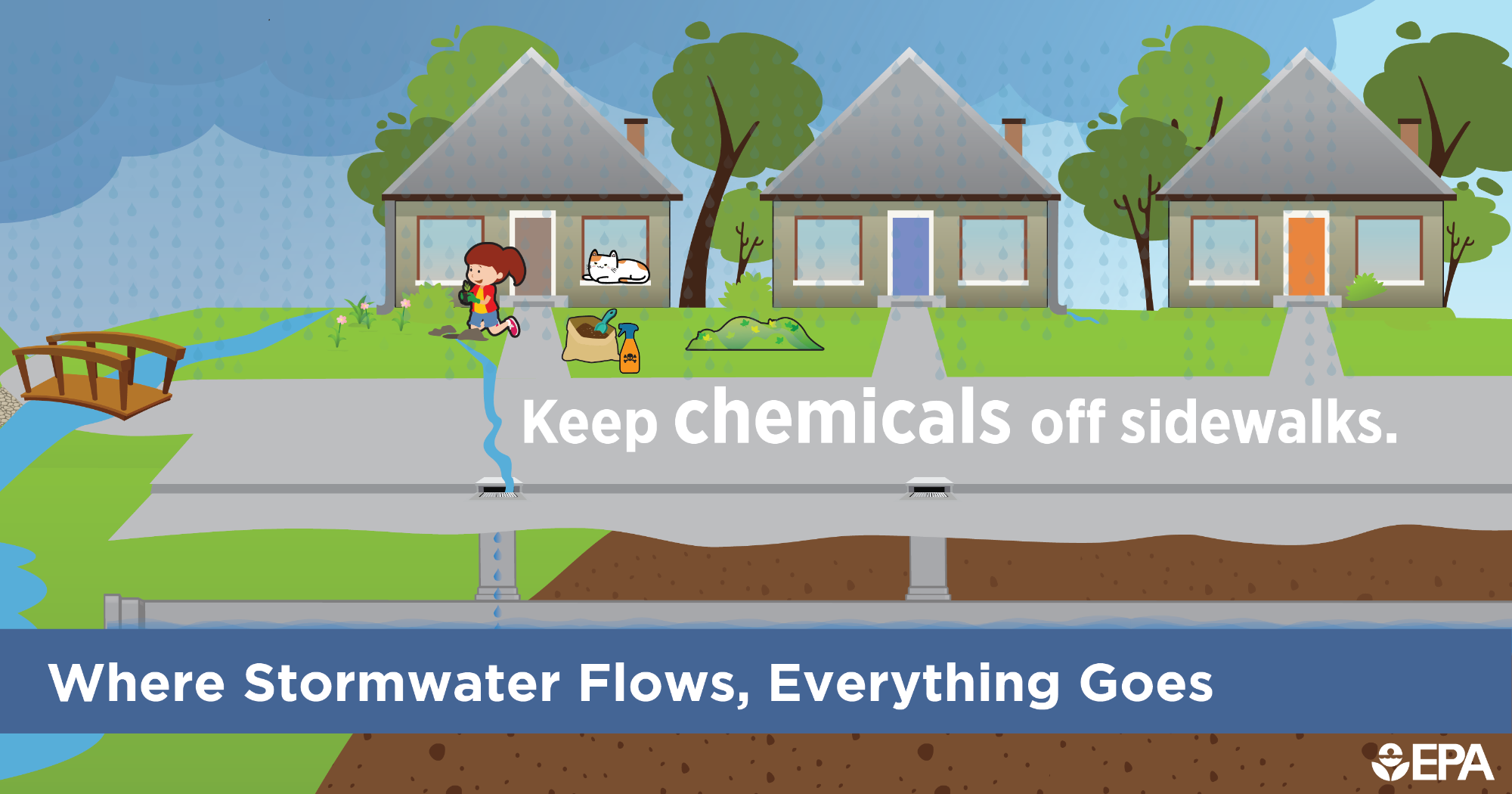
Pet Waste and sewage
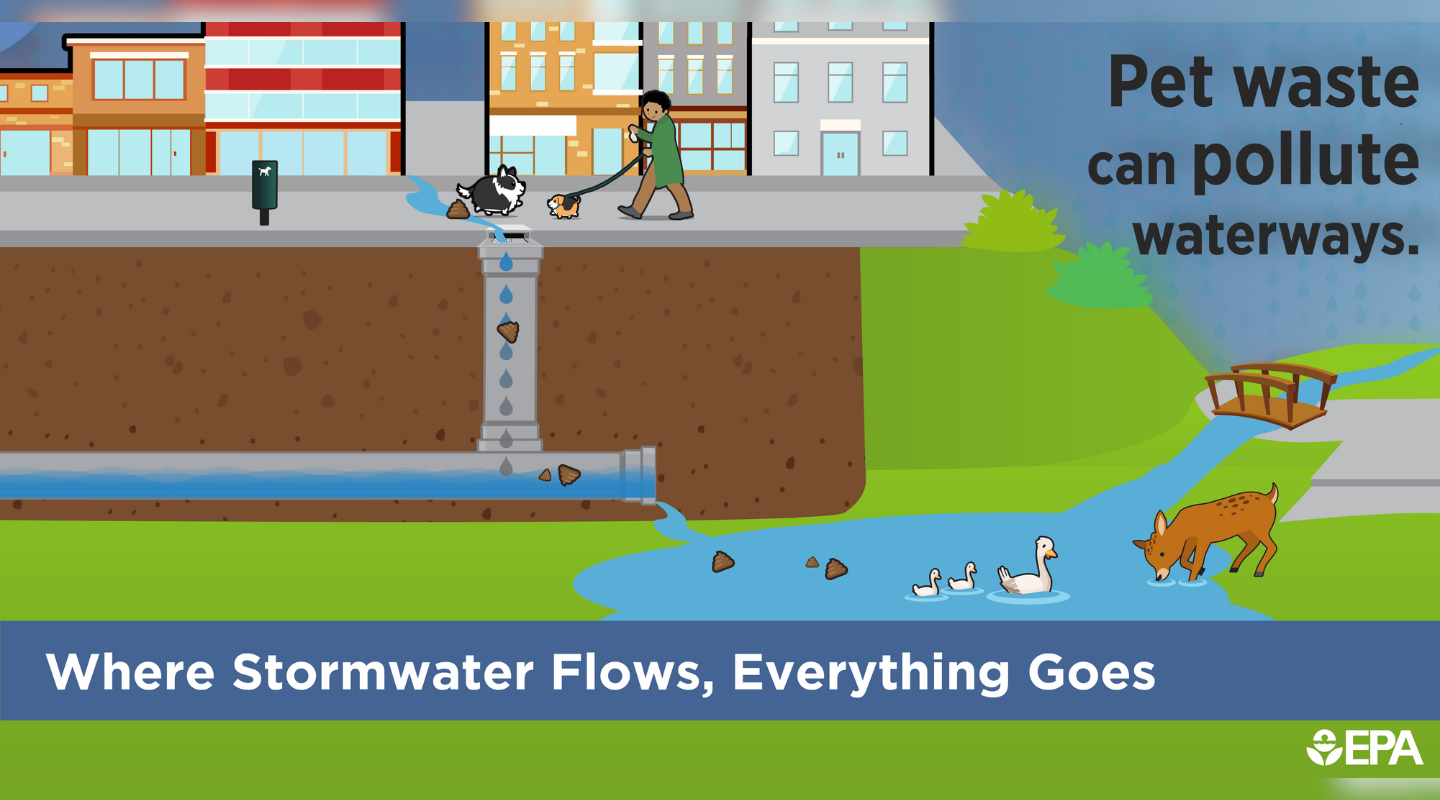
Pet waste, sewage, and other organic contaminants like animal remains can become stormwater contaminants. These forms of waste contain harmful bacteria that can cause disease. Sewage collection systems can overflow during extreme wet weather events or because of blockages caused by rags, fats, oil and grease or other debris. Septic systems that are not designed or maintained properly can flood. Rainwater will transport disease causing microorganisms and other pollutants into stormwater runoff and eventually stormwater ponds where animals or people can potentially come into contact with them.
Fertilizers and Excess Nitrogen
Nitrogen is a naural part of the soil but it can become harmful in excess. Products such as plant fertilizers contain high concentrations of nitrogen that can be abosrbed and transferred through stormwater. When nitrogen levels are high they can contribute to an unhealthy nitrogen balance within stormwater ponds and cause large blooms of algae that can harm other pond residents and smother fish by reducing the ammount of oxygen in the pond.

An algal bloom surrounded by plastic waste.

Hard waste and Trash
Solid forms of waste such as garbage often find their way into the stormwater system. Loose trash, including: food packaging, pieces of furniture, cans, electronics, and more can be picked up through stormwater runoff or end up in the stormwater system through improper disposal. These forms of waste can clog stormwater inflows and act to produce other contaminants as they break down. Plastic waste specifically breaks down into toxic microplastics that can be ingested by both people and animals.

Many forms of trash do not naturally decay and can easily become stormwater contaminants.

Loose trash can be carried through drainage pathways into the stormwater system.

A large collection of trash blocking a stormwater pond inlet.

What are the environmental health consequences of stormwater contaminantion?
Poor stormwater quality can have wide reaching consequences that reach beyond just the body of a stormwater pond. While stormwater ponds are designed with the function of gathering harmful wastewater; contaminants can still bleed into other adjacent bodies of water through underground connections spreading contaminants. The performance of a stormwater pond depends mainly on its size, regularity of management, and the kind of land usages it is surrounded by. A stormwater pond near a school and forest may recieve less direct contaminants through stormwater runoff than a pond located in the heart of an industrial area or on a major roadside for example.
Further environmental impacts of poor stormwater quality include the potential spread of bacterial pathogens and spread of cyanobacteria. The contents of leaky sewage pipes and other forms of loose waste like animal feces can enter stormwater ponds and potentially increase the risks for the spread of bacterial pathogens that are dangerous to both people and animals. A contaminated stormwater site may also promote toxic algaes like cyanobacteria which can harm both people and fish if ingested. Excess phophates in stomwater contribute to red tide: a phenomenon where large blooms of toxic algae produce harmful and often lethal conditions for marine animals by stripping oxygen from the water. Some have even suggested that the abundance of excess nutrients available within stormwater pond sites may even aid in the colonization of invasive plant species.
Sources:
(Ahmed et al. 2019) (Beckingham et al. 2019) (Delorenzo&Fulton 2009) (Jang et al. 2010) (Sinclair et al. 2020) (Skovira&Bohlen 2023) (Yang&Lusk 2018)
Aarans Pond


Site Description
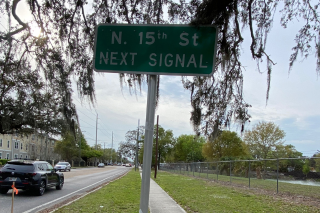
Located in the University Area where North 15th Street meets East 131st Avenue, Aarans pond is a stormwater pond site on a large fenced off tract of land. Ownership and management of the pond falls to Hillbourough County because of the University area's status as a community underbounded and not integrated with the greater city of Tampa. Aarans pond itself has 4 major inflows that recieve stormwater and one outflow that sends water into the adjacent stormwater system. From the local community, this pond recieves runoff from local buisnesses, streets, apartments, and homes. The site additionally serves as an important piece of green space; serving as habitat for animals such as marshbirds, alligators, turtles, insects, and more. Although it is formally closed to the public, Aarans pond does face significant challenges not just from stormwater pollution but patterns of illegal dumping that can result in a dirty and unpleasant appearance or possibly block crucial stormwater inflows. Improving the overall health and cleanliness of local stormwater sites is not just beneficial for stormwater functions but also overall community environmental health.
Bay News 9: Tampa's Black history in the University area can be traced to Aarans Pond
Aarans Pond Photography
Photos



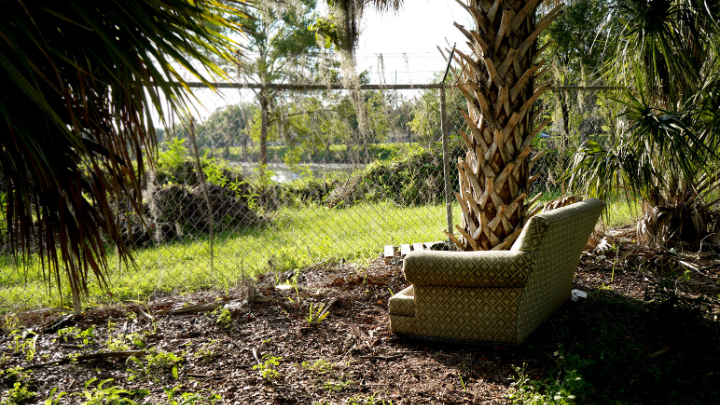
USF Student Film Projects
Here you can find two short films produced by USF students that detail the history of Aarans pond and combine that history with lived experiences from members of the University Area community and thoughts from authoratative stakeholders. They detail the challenges not just of stormwater redevelopment efforts but also the environmental and infrastructural issues community members face related to stormwater.
Authoratative Perspectives
Local Perspectives
Community Involvement
USF's Stormwater Research

Researchers from the Department Of Civil and Environmental Engineering at USF are currently exploring options in the University area to create and install a new kind of stormwater filtration system to catch and filter excess stormwater contaminants. By placing plants and permiable soil contents at the inflow locations where stormwater enters a pond, these "Biopods" should assist in creating a healthier stormwater system by helping to filter out contaminants such as excess nitrogen before they enter the pond. We're currently looking for the rich knowledge of local community members to learn more about community concerns, desires, and suggestions, for potential stormwater pond redesign.
How To Get Involved?
Anthropologists and environmental engineers from USF are interested in hearing about how members of the University area community feel about local stormwater ponds and potential stormwater pond redevelopment. The lived experiences of community members are an important form of knowledge for understanding local stormwater and the space of the University Area. We'd love to hear about your current feelings about stormwater, experiences living in the area, and future desires for stormwater pond sites. We're always looking to hear more from University Area community members so if you'd like to share your thoughts the links below are for you!
Want to Reach Out and Get Involved?
Even if you don't see yourself as particularly knowledgeable about stormwater your thoughts and lived experiences matter. If you'd like to get involved and share your input please fill out the form below.
Interested In Sharing Your Concerns and Desires?
If you want to share your suggestions, desires, or concerns for the possible redevelopment of local stormwater pond sites please fill out one of these short forms below.
How can you improve stormwater health?

You can take initiative through many individual actions to impact the overall health of your local stormwater system. While one person cannot singlehandely prevent large scale issues such as the inflow of industrial contaminants you can make a difference through smaller personal choices. This can include simply making sure that you are properly disposing of substances such as motor oil, household cleaners, and other forms of chemical waste.
Avoiding the excess use of fertilizers or other nutrient rich garden products that may flow into stormwater ponds. Cleaning up after your pets when they may leave waste behind, and likewise responsibly disposing of trash so that it does not end up sitting on the ground and potentially clogging important stormwater pathways. Although small actions individually, these are some of the ways you and your community can be stormwater conscious. Raising awareness for these issues is another pathway to making a positive effort to improve stormwater health.
Public Outreach
Members of the project also frequently attend local events in the University Area community. Feel free to come up, have a conversation, and even ask some questions if you see us!

